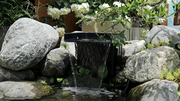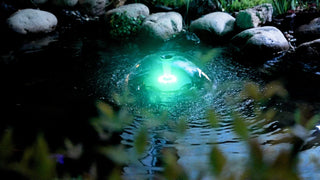
There's almost a hypnotic quality to the soft gurgle of water flowing in a garden. A small waterfall doesn't just sound good, though—it transforms a stagnant pond into a soothing, living space in which you can unwind after a long week. The best part? You don't need an army of contractors or weeks of backbreaking labor to do it. With a well-designed pond waterfall kit, you can have a beautiful installation up and running over the course of a weekend.
Whether you are a veteran gardener or tackling your first do-it-yourself pond waterfall, this step-by-step guide—based on professional practice and Poposoap's eco-engineered product design principles—will take you through the process from setup to finishing touches.
Choosing Your Waterfall Kit
Before breaking ground with a shovel, you need the right equipment. The heart of any garden waterfall installation is the pump and filtration system that circulate water.
Pumps and Flow Rate:
A small pond can be served well by a solar pump like the one supplied by Poposoap. It delivers gentle circulation of water without electricity, which fits right in with the concept of eco-friendly garden design. Poposoap pumps have small solar panels and operate silently, which makes them ideally suited to backyard waterfalls.
Filter Systems:
A good filter keeps the water clean and discourages clogging. Reusable filter boxes from Poposoap are a perfect fit for a mini waterfall project—it filters out debris without losing the good bacteria that balance the environment.
Tubing and Spillway:
Your kit will include flexible tubing and a spillway (or weir) where water is discharged into the pond. Choose a kit suitable for the size of your pond; too much flow will overwhelm a small pond, and too little a pump will leave the water stagnant.
Materials and Sustainability:
As noted in the Poposoap Brand Story, it does make a difference to choose products made from environmentally friendly materials. Weatherproof coatings and non-toxic plastics ensure the installation lasts without harm to wildlife.
Before breaking ground, ensure your kit includes:
- Solar or electric pump
- Filter box
- Tubing and connectors
- Spillway unit
- Decorative rocks (optional but highly recommended)
Tools and Prep Work
Building a waterfall is half art and half engineering. Preparation is the key to success.
You'll Need:
- A shovel and trowel for shaping slopes
- A spirit level for preserving the balance of the spillway
- Scissors or a utility knife for cutting tubing
- A small rake for grading soil
- Waterproof sealant (if required by your kit)
- A pair of work gloves

Plan Your Layout:
Decide where your waterfall will be situated in relation to your pond. It's preferable if it will flow from a slightly elevated area, creating natural movement without steep drops. Homeowners usually choose a corner or edge that is easily visible from seating areas.
Power and Sunlight:
If you’re using a solar pump, make sure your panel gets at least six hours of sunlight per day. Poposoap’s solar kits use adjustable panels, allowing flexible positioning away from shaded areas.
Create Your Base:
Mark the position of your spillway and tubing. Dig a shallow trench to accommodate the tubing run between the pump (in the pond) and the spillway (above). The slope should be gradual—maybe one inch drop per foot of run—for even water flow.
Preparation is the most lengthy, but it sets the stage for a waterfall that looks natural and runs without a hitch.
Step-by-Step Installation Guide
Now that your tools and design are ready, it is time for the fun part—building your DIY pond waterfall.
Step 1: Place the Pump and Tubing
Position the pump inside the pond, ideally at the deepest point. Connect the tubing securely to the outlet. If you’re using a Poposoap solar pump, you’ll notice how lightweight and portable the unit is—no cords, no outlets, no stress. Route the tubing up your trench toward where the spillway will sit.
Step 2: Build the Waterfall Base
Use stones, bricks, or concrete blocks to form the base structure. Stack them carefully to create a small hill behind your pond. The height doesn’t need to exceed 2–3 feet for smaller spaces; the goal is a natural flow, not a torrent.
Step 3: Install the Spillway
Position the spillway or waterfall box over your base. Level it to ensure it's even; this lets water flow evenly across. Attach the tubing to the inlet of the spillway via clamps or fittings that were included with your kit.
Step 4: Install the Liner (If Necessary)
Some kits include a liner to direct water. If so, lay it beneath your waterfall rocks and extend it slightly into the pond. This prevents leaks and soil erosion.
Step 5: Test the Flow
Operate the pump prior to decoration. Note how water cascades over the rocks and adjust until flow and sound are right. Too much? Add another rock or diverter. Too little? Adjust tubing nearer to the spillway edge.
Step 6: Incorporate Finishing Stones
Once the flow looks good, conceal the tubing and liner with decorative rocks. Poposoap’s Product Manual recommends using smooth river stones or slate pieces that match your pond’s natural tones.
Step 7: Adjust Solar Panel (for Solar Systems)
Angle the solar panel toward direct sunlight. Poposoap’s adjustable mount makes this easy even in partially shaded gardens.
That's it—a garden waterfall installation is finished. These steps can be handled in a weekend by most homeowners with little experience.
Safety and Positioning
Safety and longevity go hand in hand. A well-installed waterfall is not only beautiful to look at but safe and easy to maintain.
Electrical Safety:
If using an electric pump, plug it into a GFCI outlet rated for outdoor use. Keep cords above ground and away from footpaths. Poposoap’s solar systems eliminate these concerns entirely by using clean, wire-free power.
Positioning Tips:
- Keep your waterfall visible from your main garden area—it’s a natural focal point.
- Avoid placing it directly under trees; falling leaves can clog filters.
- Ensure the pump remains fully submerged to avoid overheating.
- Make the spillway accessible for seasonal cleaning and maintenance.
Ecological Considerations:
Poposoap environmentalism encourages constructing ponds that support local biodiversity. Develop non-toxic environments, soft water movement, and natural rock edges that provide safe perches for birds, frogs, and dragonflies.
Final Touches and Maintenance
Now comes the artistic portion—blending your waterfall into its surroundings.

Landscaping:
Plant marginal plants like rushes, irises, or water lilies around the pond edge. Their texture softens the stonework and invites beneficial insects. Plant ferns or ornamental grasses nearby for green framing.
Lighting:
Solar-powered LED spotlights at the waterfall base add drama after sundown. The solar fountain kits by Poposoap are auxiliary light compatible, so it's simple to add them without running extra cables.
Maintenance:
Like any water feature, your waterfall needs minimal maintenance to stay pristine:
- Rinse the pump impeller every 2–3 weeks to prevent any debris buildup.
- Clean filter sponges once a month, as suggested in Poposoap's Product Manual.
- Scoop leaves that have fallen as soon as possible to avoid clogging the flow.
- In winter, drain and store solar parts indoors to protect them from freezing.
Sound and Flow Adjustments:
You can also adjust your waterfall's sound profile by rearranging rocks. Placement higher up results in a more energetic trickle; flat stones produce a soft murmur. The adaptability of DIY pond waterfall arrangements allows you to tinker until the atmosphere is comfortable.
Eco-friendly Operation:
Thanks to the solar technology built into Poposoap systems, your waterfall runs entirely on renewable energy. It’s cost-free, quiet, and kind to the environment—embodying the brand’s ethos of “ecological beauty through simplicity”.
Final Thoughts
Including a pond waterfall can sound like a big job, but with the right kit and planning, it's certainly achievable over the course of a weekend. Most importantly, it adds depth, movement, and peace to your garden—turning even a small pond into a relaxation focal point.

Poposoap's collection of solar-powered filtration systems and pumps make the job a lot easier, safer, and more eco-friendly. Their systems combine modern engineering with natural design, allowing homeowners to achieve stunning garden waterfall installs without complex wiring or ongoing costs.
A waterfall doesn't just adorn your pond—it brings it to life. The soft melody of moving water beckons birds, cools the air, and creates a rhythm that's both soothing and earth-friendly. With a little patience, creativity, and the right tools, you'll be wrapping up the weekend not just with a project completed—but with a lasting sense of tranquility every time you step outside.
Editorial Note: All opinions, product recommendations, and practical guidance expressed are based on Poposoap's professional engineering standards and real-world installation experience.
Disclosure: This article includes links to Poposoap products. Our recommendations are independent and based on product performance and eco-friendly design principles.








